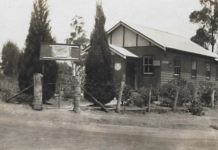
As a movement of churches, we have decided that one of our core values is to be mission-shaped. That is a lofty value, one not to be taken lightly, and if we are to live, it those of you who are charged with the responsibility of leading our churches into the mission of Christ should be focused on two vital questions: What is the shape of the mission of our church (biblical and contextual)? How do I mobilise our church into the mission of Christ?
The first question reflects your concern for a deep understanding of mission. Can you say that you fully understand the biblical shape of Christian mission? For example is mission just another thing the church does, or is it fundamental to the identity of the church – as a sent people (John 20:21)? Can you really see how central mission is to the biblical story? Can you see its centrality to ecclesiology? Have you read what Leslie Newbigin teaches about a Trinitarian missiology? And what does it mean, as Darrell Guder writes, to, ‘be the witness, do the witness and say the witness’? If we are to be a truly mission-shaped movement of churches our leaders must become biblical missiologists.
For further reading on this, why not grab Alan Roxburgh’s Missional: Joining God in the Neighbourhood, or Alan Hirsch’s The Forgotten Ways (which now comes with a workbook), or even my book The Road to Missional.
But furthermore, how are we to understand the shape of mission contextually? What does it mean, for example, to live as signs to the Lordship of Christ in the West in 2014? How do we live gratefully in a culture of consumerism? And how do we live communally in a culture of individualism? And what does Christian mission look like in your neighbourhood or town, knowing as we do that mission will be differently shaped in Campbelltown to Coogee, or in Manly to Murwillumbah? Biblical mission looks different when lived out among farmers in the midst of drought, or among asylum seekers, or new home buyers in western Sydney, or within Indigenous Australian communities, or in multicultural Wollongong. No book or off-the-shelf resource can help you here. You must become the expert in what mission in your neighbourhood looks like.
The second question is: how do I mobilise my church into the mission of Christ?
Simply setting mission as a core value is one thing, but mobilising others requires intentionality and commitment. If your people are like all people they’ll be motived primarily by fear and laziness, the two most fundamental expressions of human sin. In fact, all ungodly human responses find their root in either fear or laziness. But Christian mission requires courage and hard work. If our churches are to be mission-shaped they are to be shaped by the Spirit of the risen Christ himself, countermanding all our unconscious impulses to fear and laziness. Mobilising redeemed sinners into mission means teaching, correcting, rebuking, encouraging and nurturing them to embrace the courage and work that was modelled by Jesus. It also involves allowing the Holy Spirit to empower those qualities in our lives today. John V Taylor, in his ground-breaking work on the Holy Spirit, The Go-Between God, wrote this:
The chief actor in the historic mission of the Christian church is the Holy Spirit. He is the director of the whole enterprise. The mission consists of the things that he is doing in the world. In a special way it consists of the light that he is focussing upon Jesus Christ.
Here are a few ways you could seek to catalyse a mission shape to your church:
1. Model it
There is no doubt in my mind that church leaders cannot mobilise people into mission unless they are themselves actively engaged in it also. There’s an old adage that goes like this: “You cannot lead where you will not go; you cannot teach what you do not know”. How true this is for Christian mission. You don’t need to be the best evangelist or the most effective at alleviating suffering or contributing to society, but you do need to model your enthusiasm for it and your willingness to get your hands dirty in the service of others. Pushing a church forward from behind rarely works, but it definitely never works when to comes to mission.
2. Preach it
It’s my view that the mission of Christ ought to feature in every sermon, in one way or another. And I don’t mean by this that we preach on it as the topic every week, but rather, since the mission of God is the direction of the whole biblical story it should appear to some degree in every message. The biblical story from Genesis presents a narrative of creation, curse, covenant, Christ, church, and consummation. It describes the way God is recovering his good purposes for his creation and also calling a people to live as signs to his restorative reign. As the mission of God is the direction of the whole biblical story, it is rightly expressed in every sermon.
3. Pray for it
Earnest prayer precedes vigorous mission. Jonathan Edwards called the church to persistent prayer for revival and Isaiah 62:6-7 was one of his favourite texts. It gave him one of his best known catchcries: give him no rest!
I have posted watchmen on your walls, Jerusalem; they will never be silent day or night. You who call on the Lord, give yourselves no rest, and give him no rest till he establishes Jerusalem and makes her the praise of the earth.(Isa 62:6-7)
Edwards claimed that God’s people should give him no rest, pestering him continuously to establish his reign on earth. Erroll Hulse, entitled his book on revival Give Him No Rest. Hulse wrote that those who emulate the dedication of the watchmen in Isaiah’s text, “…know that it is the absolute determination of the Lord whom they serve to promote the glory of his Son.”
There have been recent prayer movements like the 24/7 “boiler rooms”, but these initiatives come and go. We need to foster a regular rhythm of missonal prayer. At Morling we get our student body to form into prayer triplets to pray for unsaved friends throughout the year. If you can’t get your people praying for the extension of God’s kingdom it’s hard to imagine you mobilising them into action.
4. Worship for it
By ‘worship’ I am referring to our corporate experience of worship. Given that mission is central to what it means to be ‘in Christ’ (John 20:21), I take it that part of the goal of worship is to mobilise God’s people into mission. In fact, for a genuinely missionshaped church, worship will be both an expression of praise for the God who is at work within us in the world, and a time for calling upon him to act for the glory of his Son.
Here are a few ideas for worshipping for mission:
First, a ‘work liturgy’, where for eight weeks someone from the congregation is interviewed, prayed over and ‘sent’ into their place of work, to be Christ’s ambassador.
Second, take a smart phone to your church’s playgroup or the youth group or the soup kitchen or op shop or whatever your church does in mission. Film your people serving others and play it in church and let your praise to God be catalysed by your excitement at what he’s doing through your people.
Third, find songs that have a global missional vision, not just individualised Godloves- me lyrics. Teach your congregation to praise God for his universal reign in Christ. If we believe that Christ is risen, then we believe the new creation has begun. And that’s something to sing about!
The great missiologist, Lesslie Newbigin beautifully described the work of the mission-shaped church in this way:
…the Church in each place is to be the sign, instrument and foretaste of the reign of God present in Christ for that place: a sign, planted in the midst of the present realities of the place but pointing beyond them to the future which God has promised; an instrument available for God’s use in the doing of his will for that place; a foretaste – manifesting and enjoying already, in the midst of the messianic tribulations, a genuine foretaste of the peace and joy of God‘s reign.
And that’s exactly the kind of church I think every Baptist church in NSW and the ACT should strive to be like.




































As much as I love Missions and think Church should have it as its identity…I am not in total agreement with the article for one main reason. I think we need to go back 1 step further and look at how church is shaped today and begin a deconstruction. One comment made above “…If your people are like all people they’ll be motivated primarily by fear and laziness…”, as much as I understand where Mike frost is coming from (and I have been there) the problem with that statement is that it puts the blame on the “congregation” for lack of ownership of “The Gospel”. I beg to differ.
I have been a missionary for many years and am a “missions” person from head to toe. I worked overseas for 12+yrs doing church planting and evangelism. I am still involved in Missions/Evangelism etc based from Australia. However, my thinking has changed. If was to do church planting again, I would do it differently. One of the fundamental flaws we have is that Pastors/Leaders preach that we are all priests and therefore all in ministry, however, for this to happen dramatic changes need to take place within our church structures. What we predominantly have today is a structure that creates passivity and a spectator mentality. If we truly want our people to be more overt and outward looking then lets make fundamental changes to enhance this.
Time and space does not permit me to give a full and proper answer to this, but you can preach until the Lord returns and little will change because we are preaching to the wrong end of the spectrum…its starts with the leadership taking a good hard look at themselves to ask whether they become the bottle neck to the genuine work of the Holy Spirit in the life of the church… I got this quote from a Chinese Pastor I met many years ago who had been in prison for 12+ years. he said God had to remove the Chinese leaders (he being one of those) to enable the Holy Spirit to move freely amongst the people = result, different structure and church explosion. We can learn some great lessons (good and bad) from the Chinese Church during this period.
The idea of Church and the idea of Missions start within the Godhead itself. When we understand how God works within Himself we can then create Church that reflects this as best as possible. Until then we will always have the /12 hearted approach we have today. Why, not because the people are lazy and fearful, but as leaders we do not give them the proper structure and opportunity for them to want to take ownership of the Gospel…the problem starts at the top….!!!!
I think that Mike’s statement is a valid challenge to all of us who aim to encourage and leade others in following Christ…” Simply setting mission as a core value is one thing, but mobilising others requires intentionality and commitment.”…
In Matthew 4: 18-20 Jesus called people to follow him with a particular purpose of being sent out to fish/gather/call people into God’s Kingdom…..
” As Jesus was walking beside the Sea of Galilee, he saw two brothers, Simon called Peter and his brother Andrew. They were casting a net into the lake, for they were fishermen. “Come, follow me,” Jesus said, “and I will send you out to fish for people.” 20 At once they left their nets and followed him.”
It is therefore a reasonable conclusion to say that any Church vision & mission that facilitates people to follow Christ must facilitate their engagement in Christ’s mission. If being missional is not a core practice of the Church, how can we be truly following Jesus without following his way in “fishing for people”.